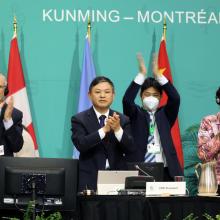
At COP15 in 2022, the Convention on Biological Diversity (CBD)’s Kumming-Montreal Global Biodiversity Framework (GBF), adopted a new global target to at least halve excess nutrients lost to the environment by 2030 (see target 7 – pollution). This landmark global agreement to safeguard biodiversity was also a key event in nitrogen policy given that target 7 is the most ambitious global nitrogen target ever adopted.
However, progress made on meeting past less ambitious nitrogen objectives was limited which means it will take far stronger commitments by all actors to accomplish the new target.
A team of experts published a comment in Nature Ecology and Evolution criticising the currently proposed indicators for nutrient pollution that would be used to monitor target 7. They claim the targets are inadequate both for tracking progress and for informing policy.
Fig 1. 'Indicators for nutrient pollution' from Successful implementation of global targets to reduce nutrient and pesticide pollution requires suitable indicators
Among other things the comment:
- Provides “a set of more relevant pollution indicators that would strengthen the GBF monitoring framework”.
- Discusses conditions for the successful implementation of the more relevant indicators.
- Defines adapting target 7 to national and regional levels as a necessary task.
- Highlights that addressing nutrient pollution requires a multisector approach that accounts for agricultural and non-agricultural sources.
- Advocates for a common, systemic and collaborative approach for the management of pesticide and nutrient pollution.

